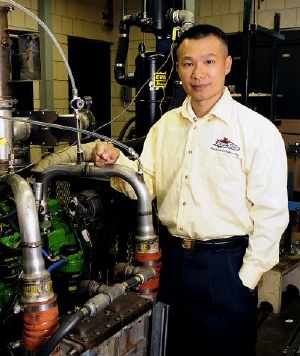Mar 9 2009
Iowa State University researchers are working to produce clean, renewable energy by developing a new, low-emissions burner and a new catalyst for ethanol production.
 Song-Charng Kong, an Iowa State University assistant professor of mechanical engineering who studies combustion, is leading a research project that aims to develop new, clean and renewable energy technologies that complement the ethanol industry. Credit: Bob Elbert/Iowa State University
Song-Charng Kong, an Iowa State University assistant professor of mechanical engineering who studies combustion, is leading a research project that aims to develop new, clean and renewable energy technologies that complement the ethanol industry. Credit: Bob Elbert/Iowa State University
Both technologies will use the synthesis gas – a mixture of carbon monoxide and hydrogen – produced by the gasification of discarded seed corn, switchgrass, wood chips and other biomass.
The burner will be designed to efficiently and cleanly burn biomass-based gas. The catalyst will be designed to convert the synthesis gas directly into ethanol.
The project is supported by a two-year, $2.37 million grant from the Iowa Power Fund, a state program to advance energy innovation and independence.
Song-Charng Kong, an Iowa State assistant professor of mechanical engineering, is leading the project. The research team also includes Robert C. Brown, the Iowa Farm Bureau Director of Iowa State's Bioeconomy Institute, an Anson Marston Distinguished Professor in Engineering and the Gary and Donna Hoover Chair in Mechanical Engineering; Victor Lin, a professor of chemistry, director of Iowa State's Center for Catalysis, director of Chemical and Biological Sciences for the U.S. Department of Energy's Ames Laboratory and founder of Catilin Inc., an Ames-based company that produces catalysts for biodiesel production; Samuel Jones, an assistant scientist for the Center for Sustainable Environmental Technologies; plus seven graduate students and two post-doctoral researchers.
The project also includes two industrial partners: Frontline BioEnergy, an Ames-based company that builds commercial-scale gasification systems; and Hawkeye Energy Holdings, an Ames-based ethanol producer with plants in Iowa Falls, Fairbank, Menlo and Shell Rock.
"We're excited about this research," Brown said. "This project partners the thermochemical conversion of biomass with ethanol production."
The project will move ethanol production beyond the fermentation of simple sugars in corn kernels. The researchers' idea is to use heat and oxygen to gasify biomass and produce a medium Btu gas (called synthesis gas) that a new catalyst can convert directly into ethanol. They'll also generate the gas using air to make a low Btu gas (called producer gas) that can be used in gas-fired heating and drying equipment.
"We're not intending to replace grain ethanol production," Brown said. "We want to complement it."
The catalyst
Lin, who's leading the development of a new catalyst for ethanol production, said it may be possible to efficiently produce liquid fuel directly from synthesis gas.
The key will be carbon-based nanoparticles just a few billionths of a meter wide. The particles are made from graphite and carry a transition metal that produces a chemical reaction. That reaction converts synthesis gas to ethanol.
Lin said there is an existing chemical catalyst that can convert synthesis gas to ethanol. But that catalyst has a very low yield of ethanol, produces greenhouse gases such as methane, needs heat up to 540 degrees Fahrenheit and requires high pressures.
Lin said the new catalyst should work at lower temperatures and pressures while delivering a higher yield of ethanol.
Could the technology be commercially viable?
"It's premature to say whether we have a realistic chance of that or not," Lin said. "But I can say this has shown some exciting preliminary results."
Benefits
The three Iowa State researchers said the project has potential to do a lot more than develop new technologies and patents.
A project summary says using biomass to produce ethanol and provide heat for ethanol production can reduce the nation's dependence on foreign oil, reduce the carbon footprint of ethanol plants, increase the plants' renewable energy ratio, boost the profitability of biorefineries and put energy dollars into local economies.
John Reardon, the research and development manager for Frontline BioEnergy, said an ethanol plant that produces 100 million gallons per year could buy enough biomass to add $10 million per year to the local economy. He also said repowering conventional ethanol plants with biomass-based gas could create more than a thousand new engineering and construction jobs over a 10-year conversion period.
Brown said all that can add up to "a potential evolution of the ethanol industry."